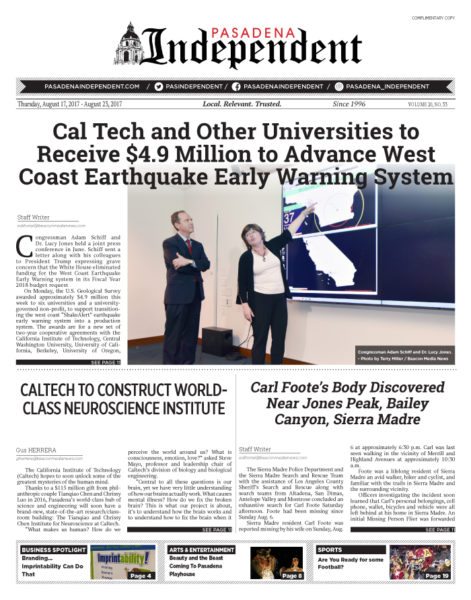
By Gus Herrera
The California Institute of Technology (Caltech) hopes to soon unlock some of the greatest mysteries of the human mind.
Thanks to a $115 million gift from philanthropic couple Tianqiao Chen and Chrissy Luo in 2016, Pasadena’s world-class hub of science and engineering will soon have a brand-new, state-of-the-art research/classroom building: The Tianqiao and Chrissy Chen Institute for Neuroscience at Caltech.
“What makes us human? How do we perceive the world around us? What is consciousness, emotion, love?” asked Steve Mayo, professor and leadership chair of Caltech’s division of biology and biological engineering.
“Central to all these questions is our brain, yet we have very little understanding of how our brains actually work. What causes mental illness? How do we fix the broken brain? This is what our project is about, it’s to understand how the brain works and to understand how to fix the brain when it doesn’t work,” continued Mayo, “the Chen Neuroscience Research Building, which is being accelerated by one of the largest gifts in Caltech history, will bring together some of the world’s most pre-eminent neuroscientists to solve one of the greatest mysteries of the universe: ‘how our brains work.’”
In addition to potentially altering the course of scientific history, the project will also re-define the northwest corner of Caltech’s campus with a three-story, 155,000 square-foot complex, literally designed to promote the serendipitous interactions that so often spur moments of innovative brilliance.
Located along Del Mar Boulevard, between Wilson and Michigan Avenues, the building’s L-shaped design will house five interdisciplinary research centers, a 150-seat lecture hall, conference rooms, meeting lounges, kitchen space, and faculty/administrative offices.
The structure will be designed to funnel internal foot traffic from the two research wings (located on opposite sides of the building) into a “collaboration knuckle” or “nucleus.”

Francisco Owens, lead designer and architect from SmithgroupJJR, hopes the design will create “casual collisions” amongst researchers, students, faculty, and staff. He envisions simple coffee runs turning into chance encounters, opportunities for discourse, and, potentially, intellectual breakthroughs.
Mayo revealed the importance of collaboration, “modern neuroscience, particularly how it’s practiced at Caltech, is a very collaborative endeavor. Caltech … has achieved greatness in science and engineering because it’s organized its campus … through collaboration.”
While presenting the project to the Pasadena Design Commission for preliminary consultation, Mayo recollected the work of Caltech’s Roger Wolcott Sperry, 1981 Nobel Prize winner for his split-brain theory.
Mayo described a time when neuroscientists would meet just about anywhere possible: in hallways, break rooms, or around the mailboxes.
“This building is literally trying to … enhance serendipity and bring back this glorious era of Caltech neuroscience, where people interacted in a casual way and enhanced [their] work,” said Mayo.
In order to clear the way for this monumental project, one single-family home will be demolished and an existing Bungalow Court (previously deemed eligible for listing in the National Register of Historic Places) will be relocated a few blocks away, to the corner of South Catalina Avenue and San Pasqual Street.
Pasadena Heritage, through executive director Sue Mossman, expressed its support for Caltech’s efforts to find a new home for the historic Bungalow Court.
Additionally, 37 trees will be removed (14 of which are protected) and one protected native tree will be relocated.
From a landscape perspective, the building will incorporate adjacent courtyard spaces and extend the Moore Walk pathway from Wilson to Holliston Avenue, fulfilling one of the school’s master plan objectives of completing an east-west thoroughfare.
The architects also hope to extend the theme of collaboration to the outside of building, using colonnades and park-like spaces to promote casual interactions between passersby.
The neuroscience institute is expected to open in the fall of 2020, according to Caltech’s website.






